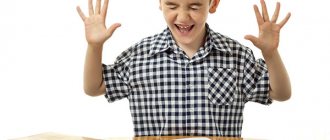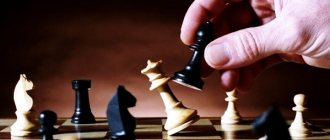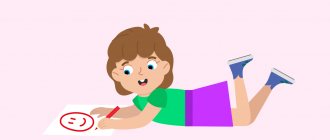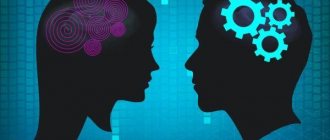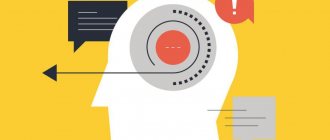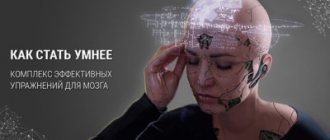Visual form of thinking in preschool age
In psychology, several forms of thinking are distinguished, most of which are formed in adulthood.
Before entering school, children go through the following mental stages:
- clearly effective;
- visually figurative;
- verbal logical thinking.
In the future, the formation of intuitive, analytical and empirical forms continues.
Visual types of thinking are most important for preschool age. It is the successful passage through these stages that provides the future adult with the ability to form judgments about events and draw conclusions.
Clearly effective
Visually effective thinking is fully formed by the age of 3. Starting from the age of one and a half, boys and girls “think” with their hands.
The main features of visually effective thinking are the use of one’s own fingers as a tool of cognition.
Connecting broken halves, breaking or disassembling a toy - all this is a way of primary perception of objects and an opportunity to understand what surrounds a little person. That is why this type of cognition is called visually effective. Mastering an action—for example, stacking cubes into something similar to a structure—occurs after several successful attempts to assemble a turret or house.
Visually figurative
From about 3 years old, a new type of thinking begins to form: in addition to studying the world with one’s hands, a system of images imprinted in memory is added.
This means that the baby can visually reproduce an already familiar object, information about which has settled in memory. The skill of using an image is especially evident during drawing or sculpting.
Detailed image accuracy should not be expected at this age. The preschooler draws exactly those features that, in his opinion, characterize this or that object. The tree will have a trunk and branches. The house must be equipped with a roof and walls.
During this period, it is especially important for parents to encourage their child to engage in any activities related to visualization.
It could be:
- applique made of colored and shiny paper;
- games with constructors;
- drawing with pencils, crayons, paints;
- modeling from clay and plasticine.
Development in childhood
Any type of thinking is developed through actions, play and communication with adults. In children, the formation of thinking takes place in 3 stages :
- Actionable thinking. It is characterized by solving simple problems through the manipulation of objects - children's development occurs through the exploration with their hands of all objects and objects that they see: a striking example is the use of fine motor skills when the child pulls, opens, and twirls.
- Creative thinking. The peculiarities of this type of perception are manifested in the fact that the child learns to create in his imagination the possible consequences of his actions. This type of mental activity is the most significant and prevails over others during the period of study at school and higher education institution.
- Verbal-logical. Children develop the ability to think in terms of concepts that are expressed through words. For a small child, a word is an association with an object or subject that the baby knew before . Example: the word “dog” in the baby’s mind means a specific dog that he has met before. At an older age, children are already capable of generalization.
The participation of parents in the development of all forms of mental activity at an early age is extremely important. Forming visual and effective thinking does not require a lot of effort and time; it is enough to regularly play some games with your baby:
- Before the age of one, teach your baby to use ropes to reach an object of interest to him. Example of use: tie a rope to a toy and position it so that the child only needs to pull the rope to get the toy. Change toys periodically to keep your baby interested.
- When a child begins to stand up, it is common for him to throw away toys and watch them fall. Tie toys to the side of the crib so that your baby can pull the rope to get the toy.
- When the baby begins to sit, try playing the following games with him: place an interesting object, for example, a ball or cube, in his field of vision, tie a ribbon to it and put one end in the baby’s hands.
Parents can come up with similar games themselves, the main thing is to stick to the goal of teaching children to use any object to get a result.
How visually effective thinking develops in preschoolers
Supporting the development of visually effective and imaginative thinking in preschoolers is simple: the key goal of parents is not to interfere with the dismantling or “modernization” of objects. The only limitation is security measures. Materials should be as harmless as possible for younger preschoolers.
Object actions do not immediately lead the child to understand the main features and purpose of the object. It takes time and repeated manipulations for the child’s mind to grasp visual generalizations and build the necessary connections.
For example, if a preschooler made his first attempts to draw with a pencil, then when he sees colored crayons he will not imagine their purpose without preliminary tests.
It is especially effective to form the memory of images with the help of flowing and bulk materials. The child pours sand from hand to hand, makes slides from cereals, and pours water. Constant touching allows him to first determine and then remember that if the sand is properly crushed, it will turn out to be a Easter cake.
To summarize what has been said, the basic principle of the development of this form of thought process is expressed in repeated actions leading to the same result: a picture, an assembled toy, a sculpted figurine.
This is how the first ideas about specific objects and life experience arise, which lay the foundation for the development of mental forms.
Development of thinking in young children from visual-effective to visual-figurative.
Development of thinking in young children from visual-effective to visual-figurative.
Early age is the period from one year to 3 years. At this time, the most important changes occur in the mental development of children - thinking is formed, the motor sphere is actively developing, and the first stable personality traits appear. Thinking during this period is associated with perception - establishing connections between objects and acting with them. Behavior and consciousness are entirely determined by what the child sees here and now.
The first thought processes arise in a child as a result of learning the properties and relationships of the objects around him in the process of perceiving them and acting with them. In objective activity, during the transition from manual operations to instrumental ones in the process of mastering social ways of using things, the emergence of intellectual activity—visual and effective thinking—occurs. The initial stage of the development of thinking - its visual and effective form - is manifested in the fact that the child practically manipulates things and grasps the connections between them.
How does a child’s thinking develop? The first manifestations of visual-effective thinking can be observed at the end of the first - beginning of the second year of life. As the child masters walking, his encounters with new objects expand significantly. Moving around the room, touching objects, moving them and manipulating them, the child constantly encounters obstacles, difficulties, looks for a way out, making extensive use of trials, attempts, etc. in these cases. In actions with objects, the child moves away from simple manipulation and moves on to object-play actions that correspond to the properties of the objects with which they are acting: for example, he does not knock the stroller, but rolls it; he places the doll on the crib; puts the cup on the table; stirs in a saucepan with a spoon, etc. By performing various actions with objects (feeling, stroking, throwing, examining, etc.), he practically learns both the external and hidden properties of objects, discovers some connections that exist between objects. So, when one object hits another, noise arises, one object can be inserted into another, two objects, having collided, can move away in different directions, etc. As a result, the object becomes, as it were, a conductor of the child’s influence on another object, i.e. Effective actions can be performed not only by directly influencing an object with the hand, but also with the help of another object - indirectly. As a result of the accumulation of some experience in its use, an object is assigned the role of a means by which the desired result can be obtained. A qualitatively new form of activity is being formed - instrumental, when the child uses auxiliary means to achieve a goal.
Children become familiar with auxiliary objects primarily in everyday life. Children are fed, and then they themselves eat with a spoon, drink from a cup, etc., and begin to use auxiliary aids when they need to get something, secure it, move it, etc. The child’s experience gained in solving practical problems is consolidated in methods of action. Gradually, the child generalizes his experience and begins to use it in various conditions. For example, if a child has learned to use a stick to bring a toy closer to him, then he gets out the toy that has rolled under the closet with the help of another one that is suitable in shape and length: a toy-shovel, a net, a stick, etc. Generalization of the experience of activity with objects prepares the generalization of experience in words, i.e. prepares the child for the formation of visual and effective thinking.
The development of objective activity and its “verbalization” in a child occurs with the active participation of the people around him. Adults set certain tasks for the child, show ways to solve them, and name actions. The inclusion of a word denoting the action being performed qualitatively changes the thought process of a child, even if he does not yet speak spoken language. The action designated by the word acquires the character of a generalized method of solving a group of homogeneous practical problems and is easily transferred to other similar situations. By being involved in the child’s practical activities, speech, even if only audible at first, as if from the inside, rebuilds the process of his thinking. Changing the content of thinking requires its more advanced forms, and already in the process of visual-effective thinking, the prerequisites for visual-figurative thinking are formed.
At a young age, profound changes occur both in the content and in the forms of visual and effective thinking. Changing the content of children's visual-effective thinking leads to a change in its structure. Using his generalized experience, the child can mentally prepare and foresee the nature of subsequent events.
Of particular importance for the formation of visual and effective thinking are actions that in psychology are called correlative. We are talking about actions with two or more objects, when it is necessary to take into account and correlate the properties of different objects - shape, size, hardness, location, etc. Already at the end of the infancy period, the child begins to perform actions with two objects - strings, places one on top of the other, folds, etc. However, in these actions he does not yet take into account the property - does not select and select the desired object in accordance with the shape, size, does not try arrange objects in a certain order. It is characteristic that the “content” of most toys, pyramids, cubes, inserts, and nesting dolls is aimed at developing correlative actions—selecting and connecting objects or their parts in accordance with shape and size. Of course, actions with them should be regulated and directed by the result that should be obtained (for example, a finished pyramid or nesting doll). For this, a one-year-old child needs the help of an adult, a kind of training. Correlating actions are performed in different ways depending on how to teach. If a child simply imitates an adult, i.e. performs the same actions with the same objects, he can get the result only in his presence and with direct demonstration. Therefore, it is important that the child learns to identify the necessary properties of objects, so that he himself selects and connects the parts in the required order. It is important to first interest him in the toy, to stimulate the desire to act. Initially, these actions are performed only through practical tests, because the child is not yet able to visually compare the size and shape of an object. Only some repeated action with a toy can convince him of the failure of his attempts. Only in this way will he understand that it is necessary, for example, not to squeeze in a part, but to try on until the necessary one is found. Toys - pyramids, cubes, nesting dolls - seem to themselves suggest which part is suitable. That's why they are called auto-didactic (or self-learning). With the help of external indicative actions, the child will sooner or later get the result.
At 2-2.5 years, a new type of perception is formed - visually correlated. It is called so because the property of one object now turns into a model, into a standard for measuring the properties of another. Thus, the size of one ring of the pyramid becomes the measure for the remaining rings; the necessary details are selected by eye, the correct action at the request of an adult is carried out immediately, without preliminary practical tests. Of course, visual selection based on a model is a much more complex task than simple recognition or trying on, because first you need to find objects that are the same in shape, size, and only then in color. This means that new actions are formed initially for those properties of the object that are directly involved, and only then are transferred to other, less significant ones.
In the third year of life, the child is already able to compare well-known objects that have a clearly defined shape with constant patterns that are not only actually perceived, but also imagined. So, if an object is triangular in shape, the child defines it as “like a house”, and if it is round as “like a ball”. This means: the child has ideas about the properties of things, and these ideas are assigned to specific objects. But these ideas do not form on their own. The properties of objects must be introduced to the child through specific practical actions. Repetition and reproduction of correlative actions lead to the formation of internal mental actions on their basis. Already in early childhood, a child can perform actions in his mind and is able to select the necessary parts, for example, for a pyramid or nesting doll, without external tests. The basis of a guess is an elementary form of internal action, but not with real objects, but with their images, ideas and methods of use. This kind of thinking is called visual-figurative.
List of used literature:
1. Practical child psychology: textbook / ed. T. D. Martsinkovskaya. - M., 2000.
2. Development of thinking at an early age / S. P. Novoselova. - M. - 1978.
3. Formation of thinking in children with developmental disabilities / Stebeleva E.A. - M. - 2021.
4. Child psychology / Smirnova E.O. - M. - 2006.
Formation of visually imaginative thinking
The basis of visual figurative thinking is a guess about a possible result. Before taking an action, the child imagines the end result. For example, sitting at home, a preschooler is able to draw a picture of a car, remembering the one he liked on the street.
The first rudiments appear at 3 years. To evaluate the result, tactile contact with the object is no longer always necessary. The image in the head helps to correlate the object seen with an already known category and correctly evaluate it. A preschooler can easily recognize a doll or teddy bear on a display window without having to touch it first.
The greater the number of objects that are remembered, the less often tactile contact will be required for identification, but the connections and relationships between the image and the real object will be realized.
Transition in children
The moment of transition from visual-effective to visual-figurative thinking is not always possible to accurately establish , since both of these types are closely interrelated with each other.
However, the development of visual-figurative appearance is closely related to the improvement of visual function and perception, which can be characterized by reactions of recognition of objects and subjects.
Visual-figurative thinking actively begins to develop when playing with a child begins, when he needs to imagine some kind of image of the result and the way to achieve it.
At this time, it is possible to solve the simplest practical problems: for example, assemble a puzzle or a whole picture according to ideas.
The transition of thinking is difficult to force , since the development of the nervous system has a physiological time period, but visual cognition can be actively developed with the help of various toys, pictures and other developmental tools.
Why is it important to develop creative thinking?
The very concept of “image” means the imprinting of objects and phenomena of the real world in human consciousness, the formation of an imaginary appearance.
A preschooler, especially an older one, is already able to accumulate a sufficient number of such reflections. Moreover, sometimes they are not visual, but tactile or audio in nature.
The skill of imaginative thinking greatly simplifies a child’s interaction with the outside world. To solve a given problem, he just needs to imagine all its components and find the answer.
In the future, properly developed imaginative thinking will make it easier to master spatial thinking and imagine the world in three-dimensional display.
It is especially important to pay attention to the child at the stage of development of imaginative thinking for the following reasons:
- The ability to operate with images significantly speeds up the solution of first everyday, and later logical and mathematical problems.
- The ability to think in images forms the aesthetic component of the personality and the craving for beauty, which intensifies as one grows older.
- Operating with images contributes to the development of creative thinking.
Ways to develop visually imaginative thinking
Depending on the age and preferences of the child himself, various methods are chosen, however, each is based on creating a result based on the presented image.
At the age of three, this is a game with a pyramid and similar collapsible toys. To begin with, the adult shows the process of disassembling and correctly assembling the toy, after which the child is asked to repeat the steps.
To complicate the task, you will need a pyramid with rings of various sizes. An additional effect of the toy is learning to highlight the essential properties of objects, distinguish between sizes, shapes, and shades. It can be stated that the process of developing imaginative thinking has begun when, before an action, the child is able to tell what he will now build or draw.
Basic methods applicable in older preschool age
In the future, the imaginative thinking of older preschoolers should be stimulated using the following methods and techniques:
- observation of nature with subsequent descriptions and displays of what was seen;
- comparative analysis of objects of various sizes and shapes;
- collecting puzzles with gradual complication of the task;
- drawing from memory;
- creative work with plastic materials - modeling from clay, plasticine;
- excursions to museums and exhibitions;
- displaying on paper or canvas concepts that do not have visual signs: love, friendship, thought, sound, melody;
- creating panels using natural materials, cardboard, colored paper.
The effectiveness of classes aimed at developing visual imaginative thinking in preschool age depends on the correct implementation of the stages of learning:
- demonstration;
- description or explanation;
- Team work;
- independent work according to the model;
- creativity based on a generalization of ideas about a phenomenon, not limited by any framework.
Any activity should not tire the child. As soon as he feels tired, he needs to switch his attention to another activity. In addition, it is important to constantly encourage and motivate the child, cultivating in him a true passion for the process of drawing or constructive creativity.
Meaning in adulthood
It would be wrong to assume that the visual-effective type of thinking, subsequently transformed into figurative and verbal-logical, loses its relevance for a mature person. In fact, we regularly use this form of brain activity, but we do not notice it. Examples of the use of an effective type of human brain activity in everyday life have a wide range: this is the need to understand the principles of operation of new technology, rearrange furniture, as well as all those actions in which we are not able to predict the result . Also, visual-effective thinking is especially characteristic of people whose activities have several forms: repair work, mechanical engineering activities and other types of work related to activities of a practical nature.
In conclusion
In psychology, the thinking process is a type of mental activity that results in the formation of new knowledge or a product through creativity and practical changes in the surrounding world.
In psychology, there are three stages in the formation of mental activity, through which the main age-related tasks are solved, such as: performing practical actions, creating in the imagination a plan to achieve a result and the formation of a conceptual apparatus - these are effective, figurative and conceptual types of thinking.
In the initial period of education (primary and middle school age), the degree of formation of the imaginative thought process is of great importance - after all, it is he who is responsible for creating in the head ways to solve problems and a plan of action. However, this type of thinking is not formed independently - its basis is active objective activity, which is realized in designing, drawing, assembling and disassembling various objects, etc. in infancy and early preschool age. In this regard, the task of parents is to conduct various games with their children aimed at developing visually effective and subsequently figurative forms of thinking.
